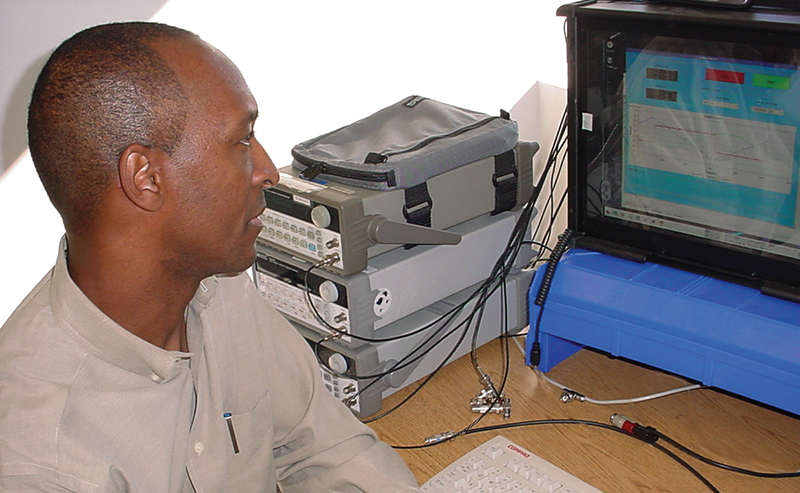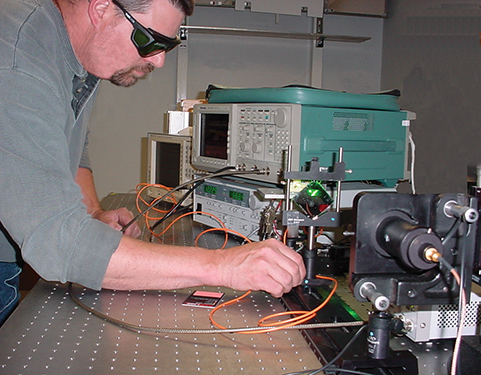
Advanced Air Data Systems for Commercial Aircraft
Originating Technology/NASA Contribution
It is possible to get a crude estimate of wind speed and direction while driving a car at night in the rain, with the motion of the raindrop reflections in the headlights providing clues about the wind. The clues are difficult to interpret, though, because of the relative motions of ground, car, air, and raindrops. More subtle interpretation is possible if the rain is replaced by fog, because the tiny droplets would follow the swirling currents of air around an illuminated object, like, for example, a walking pedestrian. Microscopic particles in the air (aerosols) are better for helping make assessments of the wind, and reflective air molecules are best of all, providing the most refined measurements. It takes a bright light to penetrate fog, so it is easy to understand how other factors, like replacing the headlights with the intensity of a searchlight, can be advantageous.
This is the basic principle behind a lidar system. While a radar system transmits a pulse of radiofrequency energy and interprets the received reflections, a lidar system works in a similar fashion, substituting a near-optical laser pulse. The technique allows the measurement of relative positions and velocities between the transmitter and the air, which allows measurements of relative wind and of air temperature (because temperature is associated with high-frequency random motions on a molecular level).
NASA, as well as the National Oceanic and Atmospheric Administration (NOAA), have interests in this advanced lidar technology, as much of their explorative research requires the ability to measure winds and turbulent regions within the atmosphere. Lidar also shows promise for providing warning of turbulent regions within the National Airspace System to allow commercial aircraft to avoid encounters with turbulence and thereby increase the safety of the traveling public. Both agencies currently employ lidar and optical sensing for a variety of weather-related research projects, such as analyzing the water content of snow and forecasting lightning.
Partnership
NASA has been working with Ophir Corporation, of Littleton, Colorado, since 1985, on a variety of remote optical sensing projects. Most of this work has been in the form of Small Business Innovation Research (SBIR) grants.
An infrared air temperature radiometer—the by-product of one of the early Phase I and Phase II SBIR projects carried out through Dryden Flight Research Center—is now resident at the National Center for Atmospheric Research. The device delivers highly accurate, remote air temperature measurements, and it provides remote detection of atmosphere thermal anomalies, precursors for the formation of clear-air turbulence and other flight hazards.
In the 1990s, Ophir’s work with NASA shifted from the weather-related sensors it had been developing to remote sensing instrumentation to measure temperature, humidity, and airspeed. The resulting measurements could be used to improve flight safety.
From 2002 to 2004, Ophir worked under new SBIR Phase I and II contracts with Dryden to provide proof-of-concept laboratory testing of a new approach to Optical Air Data Systems (OADS). Traditionally, air data is measured with several probes that are mounted on an aircraft, including immersion temperature probes and Pitot airspeed probes, as well as with flush-mounted static pressure ports.
In this project and in a follow-on effort, Ophir addressed the problem of determining the characteristics of the air outside of the boundary layer of an aircraft. This development included the use of a single sensor to replace the conventional air data sensors that are prone to such failures as icing and the plugging of Pitot tubes. An optical air data sensor now provides the potential for important benefits to high-performance aircraft. These include measurements in difficult aircraft attitudes, potentially higher update rates, and reduced calibration and maintenance costs.
Product Outcome
The company has made great strides in this research, and although the studies continue, it has already commercialized a portion of the work. Through its efforts to develop a lidar OADS for modern aircraft, Ophir has developed a technology it calls senseAir that overcomes the problems inherent to the early laser-based OADS.
Early laser-based OADS made use of the backscattered signal from natural atmospheric aerosols to measure airspeed. This approach suffered due to the fact that insufficient atmospheric aerosol loading at critical flight altitudes sometimes made system operation unreliable. Also, early systems, operating as they did on aerosol backscattered energy, did not have access to mean molecular velocity and, therefore, could not measure atmospheric temperature. Molecular density is another parameter that can be obtained using molecular backscatter, and this parameter, when combined with the temperature measurement, can provide the full set of air data information from a single system, which was not possible from systems using only aerosol scattering.
The senseAir technology can provide air data (velocity, temperature, and pressure) even when no aerosols are present—in clean-air atmospheric conditions. It does not rely on coherent, optical wavefront mixing. This is an important advantage in a high-vibration aircraft environment, since it dramatically reduces the need for precise optical alignment and thermal stability of the optical components. Moreover, atmospheric turbulence and refractive index fluctuations in the aircraft boundary layer will not degrade the performance of incoherent laser radar, such as used in this system.
The new system uses Rayleigh/Mie lidar, an optical laser-based, remote sensing technique intended to offer an option to traditional sensors used for measuring air data outside a vehicle’s boundary layer. Laser light is scattered by the atmospheric aerosols and gas molecules, and an optical receiver collects a fraction of that light. The air molecules or aerosols have a net velocity along the direction of the laser light propagation, and the center wavelength of the scattered light is Doppler shifted. (This Doppler shift is analogous to the change in auditory pitch one hears from an oncoming train or automobile.) Measuring this frequency shift allows the relative airspeed to be measured along the laser’s line of propagation.
The laser light is transmitted and collected along three different axes, and then the three-dimensional air velocity is measured. This provides total airspeed, angle of attack, and angle of sideslip. The aircraft’s airspeed is found from the Doppler shift of the Rayleigh molecular scattering augmented by the aerosol Mie scattering, and will, therefore, not fail if the air becomes free of aerosols. Measuring the airspeed on three perpendicular axes allows the aircraft velocity relative to the air to be determined.
The innovative system uses optical scattering from atmospheric gas molecules (Rayleigh scattering) to obtain the mean random molecular velocity from which atmospheric temperature is derived. Again, using the molecular backscattered signal strength, the atmospheric gas density is obtained. Then, using the ideal gas law formula, pressure is obtained to provide the remaining parameter in the set of air data parameters, with the three vector components of airspeed and atmospheric temperature.
The Ophir system shows promise for improved reliability and reducing the need for periodic calibration, thereby contributing to a reduced life-cycle cost. When the air data measurement is made sufficiently ahead of the flight vehicle, the disturbance to the measurement by the presence of the aircraft is acceptably small so that one system calibration can be used for all aircraft.
senseAir™ is a trademark of Ophir Corporation.

Ophir Corporation has developed a significant innovation in the field of Optical Air Data Systems, since its device can measure all air data parameters in both aerosol and non-aerosol conditions from a single sensor.

An Ophir Corporation engineer works with a ground-based unit that provides air data for air vehicles, as well as information for turbulence detection and wind profiling.













